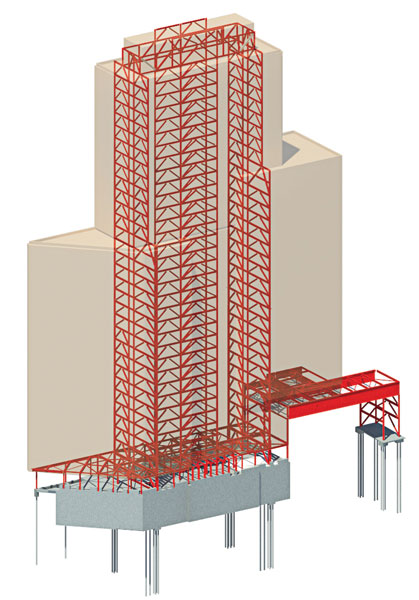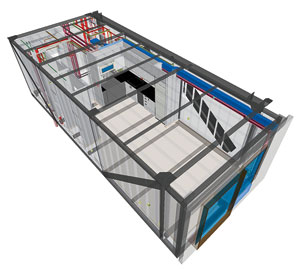Paradigm Shift
In case negotiations with the unions don't work out, Forest City Ratner has a backup plan to construct the high-rise conventionally. The modular B2 and its alternate would look identical: Both schemes call for a predominantly metal-and-glass-clad tower broken up into four volumes, each articulated by panels of different hues, patterning, and reflectivity.
At 340,000 square feet, the B2 tower will be more than three times the size of the Star Apartments. But though the scales of the projects are different, the goals are the same: By minimizing on-site construction, the teams behind both buildings say they will shorten project schedules, deliver high-quality housing, and save money. Forest City Ratner claims that using the approach will move 60 percent of the work off site and shave at least four months off an 18-month construction timeline. The developer also estimates that the modular B2 tower would cost 20 percent less than a conventionally constructed building with a concrete flat-slab structure (the typical construction method for high-rise residential buildings in New York).
  |
The developer’s preferred scheme for building the 350-apartment B2 tower includes 930 modules, each with a steel-framed chassis (above). According to the plan, the modules, including bathrooms, m/e/p services, and finishes, will be assembled in a factory not far from the site. They will be lifted into place by crane around a steel-brace frame (top) that will serve as the building's primary lateral-load-resisting system. Images courtesy SHoP Architects (above); Arup (top) |
These savings are especially significant since the Atlantic Yards site, which covers 22 acres, is ultimately projected to include 14 residential buildings. Of the 6,430 planned rental and condominium apartments, 2,250 are reserved for low- or middle-income households. As each tower is built, the developer anticipates that its modular-construction process would improve. “We expect to find even greater levels of efficiency,” says Sanna.
Similarly, the Skid Row Housing Trust, which has a portfolio of 1,600 units in 23 buildings in Los Angeles, sees modular building as an economically viable alternative to conventional construction. “We want to continue to develop housing even in the context of a tough fiscal environment,” says Mike Alvidrez, the organization's executive director.
The trust expects Star to be completed in April 2013, approximately 14 months after workers began retrofitting the reinforced-concrete-and-masonry structure that will serve as the apartment building's base, converting it into space for retail tenants, social-service providers, and recreation, including a running track and basketball court. A more typical construction timeline would be 18 to 24 months, says Theresa Hwang, community designer for the organization. She also points out that the residential floors represent only about 25 percent of the $19.7-million construction cost, even though they make up more than half of its 95,000 square feet. “Our per-unit costs are dramatically lower,” she says.
Proponents of modular construction say the efficiencies are realized by performing work in a factory environment, where labor costs are lower and the construction is not subject to weather-related delays. The savings also come from the ability to perform foundation construction and other site-bound work simultaneously with unit assembly. Advocates of the approach also tout benefits such as reduced noise and less construction-related disruption in the neighborhood surrounding the building site, as well as improved job-site safety, since so much of the work normally done outdoors, many stories in the air, is performed on the factory floor. And they cite green advantages, like reductions in construction waste and the potential for better energy performance, which they attribute to tighter quality control. (Both project teams hope to achieve LEED certification, with the B2 targeting Silver and Star seeking Platinum.)









